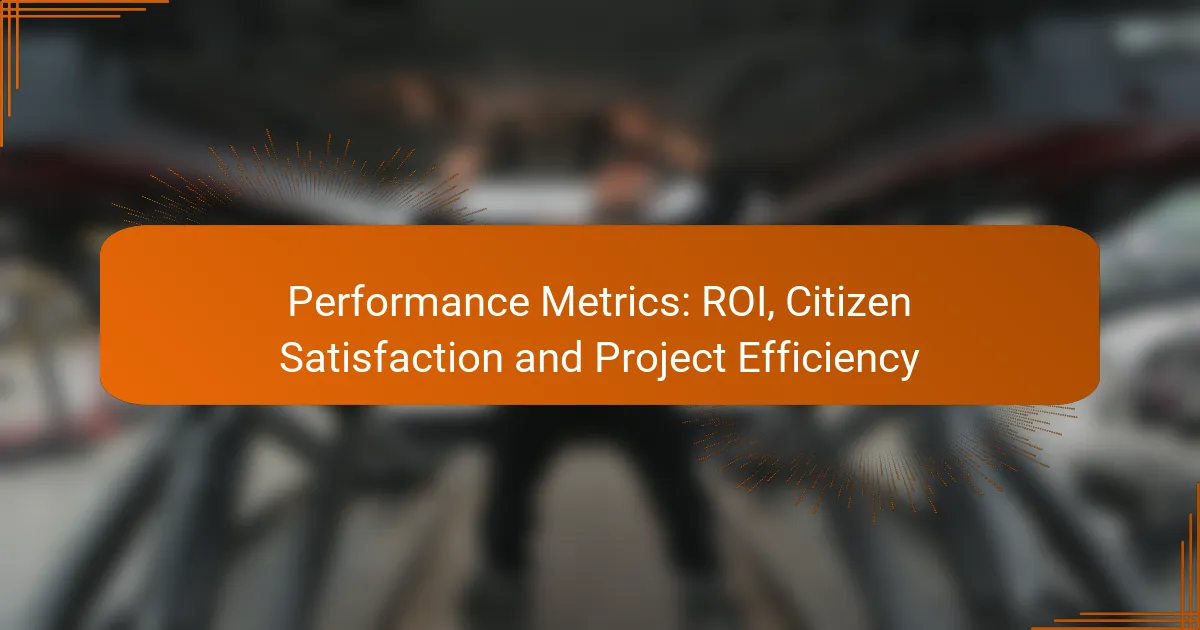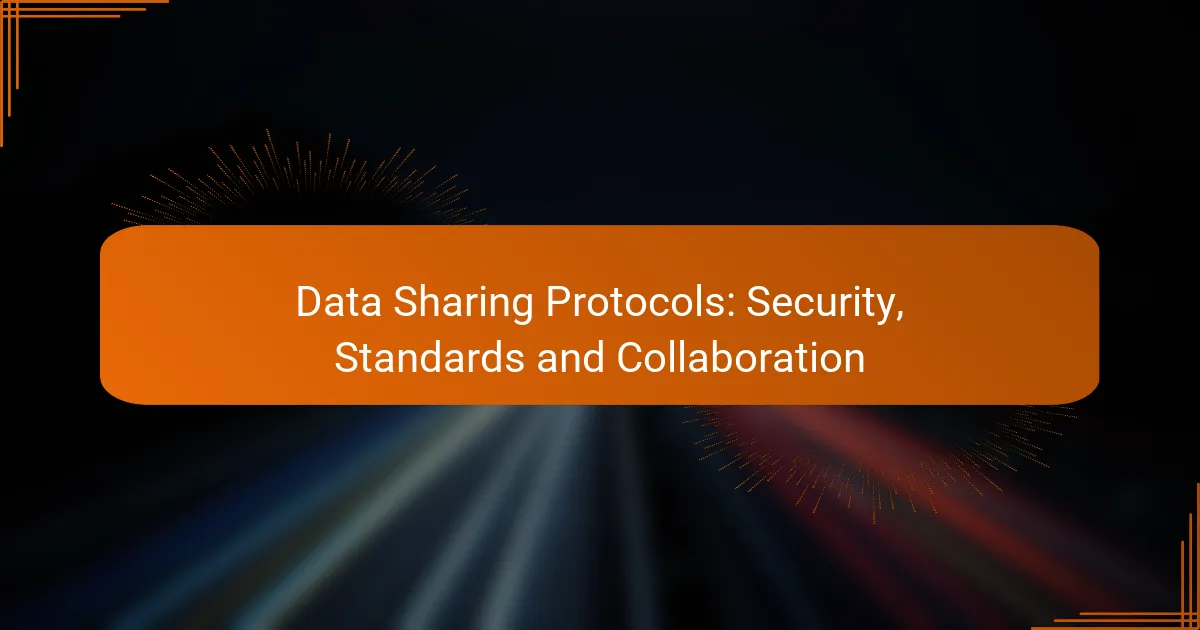Performance metrics such as ROI, citizen satisfaction, and project efficiency are crucial for evaluating the success of initiatives and services. By measuring ROI, organizations can determine the financial effectiveness of their investments, while citizen satisfaction reflects the quality of services and community engagement. Additionally, enhancing project efficiency through optimized processes and resource management leads to improved outcomes and better service delivery.

How to Measure ROI in Performance Metrics?
Measuring ROI in performance metrics involves evaluating the financial return generated from investments in projects or initiatives. This assessment helps organizations understand the effectiveness of their strategies and allocate resources more efficiently.
Financial return calculations
Financial return calculations focus on quantifying the gains from investments relative to their costs. A common method is to use the formula: ROI = (Net Profit / Cost of Investment) x 100. This provides a percentage that indicates how much profit is generated for each dollar spent.
For example, if a project costs $10,000 and generates $15,000 in revenue, the ROI would be 50%. This simple calculation helps stakeholders quickly assess the viability of projects.
Benchmarking against industry standards
Benchmarking involves comparing your ROI metrics against industry standards to gauge performance. This can highlight areas for improvement and help set realistic targets. Organizations often look at average ROI figures within their sector to establish a baseline.
For instance, if the average ROI in the tech industry is around 20%, a company achieving 25% can consider itself above average. However, it’s crucial to ensure that the benchmarks used are relevant and reflect similar operational contexts.
Tools for ROI analysis
Numerous tools are available for conducting ROI analysis, ranging from simple spreadsheets to advanced software solutions. Tools like Microsoft Excel can be used for basic calculations, while platforms like Tableau or Power BI offer more sophisticated data visualization and analysis capabilities.
When selecting tools, consider factors such as ease of use, integration with existing systems, and the ability to generate detailed reports. Utilizing the right tools can streamline the analysis process and enhance decision-making.

What Factors Influence Citizen Satisfaction?
Citizen satisfaction is primarily influenced by the quality of services provided, the level of community engagement, and effective feedback collection methods. These elements work together to create a positive experience for citizens and foster trust in public services.
Service quality metrics
Service quality metrics assess how well public services meet citizen expectations. Key indicators include response times, accuracy of information, and the professionalism of staff. For instance, a city might track the average time taken to resolve a complaint, aiming for a target of under 24 hours.
Regularly reviewing these metrics helps identify areas for improvement. Implementing standards based on citizen feedback can enhance service delivery and increase satisfaction rates.
Community engagement strategies
Effective community engagement strategies involve actively involving citizens in decision-making processes. This can include town hall meetings, surveys, and social media outreach to gather input on local issues. For example, a municipality might host quarterly forums to discuss upcoming projects and solicit feedback.
Building trust through transparency and responsiveness in these engagements can significantly boost citizen satisfaction. Ensuring that citizens feel heard and valued is crucial for fostering a strong community connection.
Feedback collection methods
Feedback collection methods are essential for understanding citizen satisfaction levels. Common approaches include online surveys, suggestion boxes, and direct interviews. Utilizing a mix of quantitative and qualitative feedback can provide a comprehensive view of citizen experiences.
It’s important to analyze feedback promptly and communicate any changes made as a result. This not only improves services but also demonstrates to citizens that their opinions matter, enhancing overall satisfaction.

How to Improve Project Efficiency?
Improving project efficiency involves optimizing processes, resources, and communication to achieve better outcomes with less effort. Key strategies include adopting effective project management methodologies, utilizing resource allocation techniques, and implementing performance tracking tools.
Project management methodologies
Choosing the right project management methodology can significantly enhance project efficiency. Popular approaches like Agile, Waterfall, and Lean each offer unique frameworks that cater to different project needs. For instance, Agile is ideal for projects requiring flexibility and rapid iterations, while Waterfall suits projects with well-defined stages.
Consider the nature of your project when selecting a methodology. If your project involves frequent changes, Agile may be more effective. Conversely, for projects with clear timelines and deliverables, a Waterfall approach might be preferable.
Resource allocation techniques
Effective resource allocation is crucial for maximizing project efficiency. Techniques such as resource leveling and resource smoothing help ensure that team members are neither overburdened nor underutilized. For example, resource leveling can adjust project timelines to prevent overallocation, while smoothing can help distribute workloads evenly across the project duration.
When allocating resources, assess the skills and availability of team members. Tools like Gantt charts or resource management software can provide visual insights into resource distribution, making it easier to identify potential bottlenecks.
Performance tracking tools
Utilizing performance tracking tools is essential for monitoring project efficiency. Tools like Trello, Asana, or Microsoft Project can help teams keep track of progress, deadlines, and deliverables. These platforms often include features for real-time collaboration, which can enhance communication and accountability among team members.
Establish key performance indicators (KPIs) to measure project success. Common KPIs include project completion time, budget adherence, and team productivity. Regularly reviewing these metrics can help identify areas for improvement and ensure that projects stay on track.

What Are the Key Performance Indicators for ROI?
Key performance indicators (KPIs) for return on investment (ROI) help organizations assess the financial efficiency of their projects. These metrics provide insights into profitability and cost-effectiveness, guiding decision-making for future investments.
Net profit margin
Net profit margin measures the percentage of revenue that remains as profit after all expenses are deducted. It is calculated by dividing net income by total revenue and multiplying by 100. A higher net profit margin indicates better financial health and efficiency in managing costs.
For example, if a company generates $1 million in revenue and incurs $800,000 in expenses, the net profit margin would be 20%. This metric is crucial for comparing profitability across different projects or companies within the same industry.
Cost-benefit analysis
Cost-benefit analysis evaluates the total expected costs against the anticipated benefits of a project. This analysis helps determine whether an investment is worthwhile by quantifying financial returns and comparing them to costs. It is essential for making informed decisions on resource allocation.
To perform a cost-benefit analysis, list all costs associated with a project, including initial investments and ongoing expenses, and estimate the expected benefits, such as increased revenue or cost savings. A project is generally considered viable if the benefits significantly exceed the costs, ideally by a ratio of at least 2:1.

How to Create a Citizen Satisfaction Survey?
Creating a citizen satisfaction survey involves designing questions that accurately gauge public sentiment and experiences with services. Effective surveys can provide valuable insights into areas for improvement and enhance community engagement.
Questionnaire design principles
When designing a questionnaire, clarity and relevance are crucial. Use straightforward language and avoid jargon to ensure respondents understand each question. Aim for a mix of question types, including multiple-choice, Likert scale, and open-ended questions to capture diverse feedback.
Limit the survey length to encourage participation; ideally, it should take no longer than 10-15 minutes to complete. Pre-testing the survey with a small group can help identify confusing questions and improve overall effectiveness.
Distribution channels for surveys
Selecting the right distribution channels is essential for reaching a broad audience. Online platforms, such as email, social media, and dedicated survey websites, can facilitate easy access and quick responses. Consider using local community forums or government websites to increase visibility.
In-person distribution at community events or public meetings can also enhance engagement, especially among demographics less likely to respond online. Offering incentives, such as gift cards or entry into a raffle, may improve response rates across all channels.

What Are the Best Practices for Enhancing Project Efficiency?
Enhancing project efficiency involves adopting strategies that streamline processes, reduce waste, and improve outcomes. Key practices include utilizing agile methodologies, implementing effective communication tools, and continuously assessing performance metrics.
Agile project management
Agile project management focuses on iterative development, allowing teams to adapt quickly to changes and deliver value incrementally. This approach emphasizes collaboration, flexibility, and customer feedback, which can significantly enhance project efficiency.
To implement agile effectively, consider breaking projects into smaller tasks or sprints, typically lasting two to four weeks. Regular stand-up meetings can help teams stay aligned and address issues promptly. Tools like Jira or Trello can facilitate task tracking and progress monitoring.
Be mindful of common pitfalls, such as neglecting documentation or failing to involve stakeholders. Ensuring that all team members understand agile principles and maintain open lines of communication can mitigate these risks and foster a more efficient project environment.



